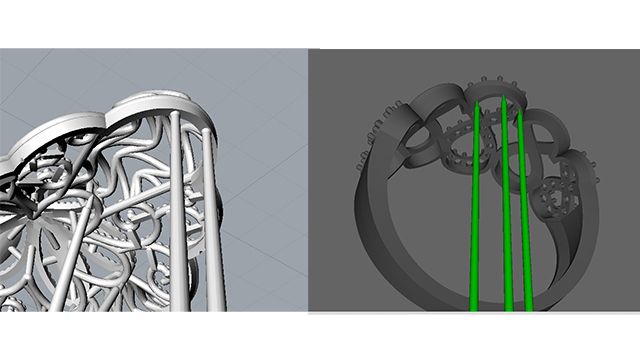CONE STYLE SUPPORT STRUCTURES VS BEL SUPPORTS STRUCTURES A CASE STUDY
Cone-Style Support Structures vs. Bel Support Structures: A Comparison

In jewelry 3D printing, the choice of support structures significantly affects both print quality and post-processing time. Two of the most commonly used support systems are Bel-style supports and cone-style supports. This blog breaks down their differences, strengths, and weaknesses to help designers and manufacturers choose the most efficient option.
What Are Bel-Style Supports?
Bel-style supports are manually placed structural elements added to a design to hold overhanging parts during printing. They come in a few different types:
- One-Point Support: A single connection from the model to the platform.
- Two-Point Support: A bridge-like support between two parts of the design.
- Point-to-N Support: A tree-like structure connecting one base to multiple contact points on the model.
These supports are integrated during the design stage, directly in the CAD environment. While they can be customized and placed precisely, they have certain drawbacks:
- Hard to Remove: They usually have round, thick contact points that are difficult to break off cleanly.
- Risk of Damage: During removal, there's a higher chance of breaking delicate features or surfaces.
- Post-Processing Burden: They often leave residue or marks that require polishing, leading to extra labor and material loss.
- Material Compatibility Issues: Harder resins may be needed for support removal, which can affect casting quality.
What Are Cone-Style Supports?
Cone-style supports are generated automatically or semi-automatically during slicing (pre-printing setup). They are slender, tapered structures with sharp tips that lightly touch the surface of the model.
Advantages of cone-style supports include:
- Fine Contact Points: Small tips make them easy to remove without damaging the part.
- Cleaner Separation: Designed to snap off cleanly, minimizing the need for aggressive finishing.
- Less Material Waste: Smaller supports leave less residue, reducing polishing and rework.
- Flexible Placement: Users can control support quantity and location to suit complex geometries.
Cone-style supports are ideal for detailed jewelry designs like filigree, thin walls, and fragile prongs.
Real-World Use Comparison
In practice, cone-style supports offer faster cleanup and better surface quality. Bel-style supports, while precise, introduce higher chances of damage and longer finishing times.
For example, removing a Bel-style support from a small prong might bend or break it. With cone-style supports, the structure often detaches cleanly without harming the part.
Final Thoughts
Both support systems have their place, but cone-style supports are often more efficient for modern jewelry workflows. They save time, reduce labor, and preserve the integrity of delicate parts.
If your priority is speed, quality, and production consistency, cone-style supports are the smarter choice for your 3D printing setup.

